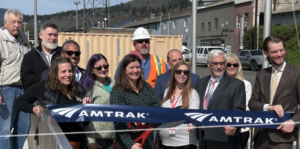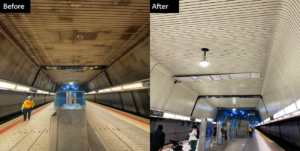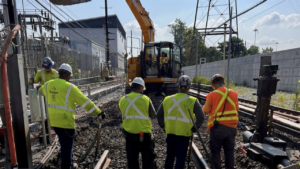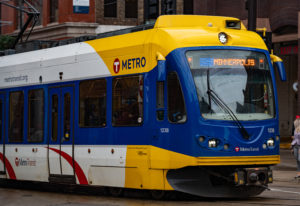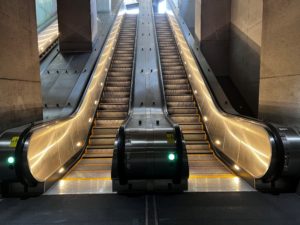FAST Act on the fast track to approval
Written by Carolina Worrell, Senior Editor, Railway Age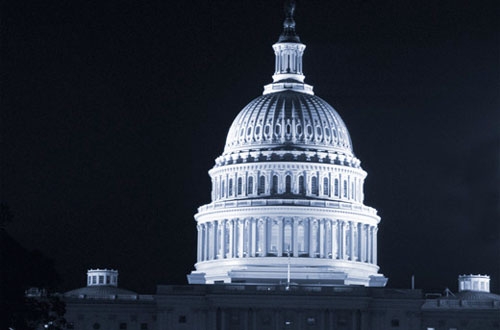
Congressional conferees on Dec. 1, 2015 reached an agreement on the Fixing America's Surface Transportation (FAST) Act, a five-year surface transportation reauthorization bill and the first long-term bill of its kind in a decade. It comes after years of predeccesor-bill extensions and partisan bickering.
UPDATE FROM EDITORS: The FAST Act was signed into law by President Obama on December 4, 2015.
Of interest to freight railroads are key provisions on safety enhancements for tank cars moving flammable liquids in the U.S. and electronically-controlled pneumatic (ECP) train braking.
On July 30, 2015, the U.S. Senate approved the DRIVE Act on a bipartisan vote of 65-34. After House passage of similar legislation, the Senate and House formed a conference committee on which Senators John Thune (R-S.D.) and Bill Nelson (D-Fla.) both served to resolve the differences between the two bills. The text of the agreement, now known as the FAST Act, is available here.
Rail provisions in the FAST Act that exited the House-Senate conference committee include the following:
• Rail Infrastructure Improvements – Improves rail infrastructure and safety by consolidating rail grant programs, cutting red tape and dedicating resources for best use. It also establishes a Federal-State partnership to bring passenger rail assets into a state of good repair.
• Expedites Rail Projects – Accelerates the delivery of rail projects by significantly reforming environmental and historic preservation review processes, applying existing exemptions already used for highways to make critical rail investments go further.
• Dedicated Funding for Positive Train Control (PTC) – Establishes a new limited authorization with guaranteed funding for the Secretary of Transportation to provide commuter railroads and States with grants and/or loans that can leverage approximately $2+ billion in financing for PTC implementation.
• Testing of Electronically-Controlled Pneumatic (ECP) Brakes – Preserves the DOT’s final rule requiring ECP brakes on certain trains by 2021 and 2023, while requiring an independent evaluation and real-world derailment test. It requires DOT to re-evaluate its final rule within the next two years using the results of the evaluation and testing.
• Liability Cap – Increases the passenger rail liability cap to $295 million (adjusting the current $200 million cap for inflation), applies the increase to the Amtrak accident in Philadelphia on May 12, 2015, and adjusts the cap for inflation every five years going forward.
• Cameras on Passenger Trains – Requires all passenger railroads to install inward-facing cameras to better monitor train crews and assist in accident investigations, and outward-facing cameras to better monitor track conditions, fulfilling a long-standing recommendation from the National Transportation Safety Board.
• Thermal Blankets on Tank Cars Carrying Flammable Liquids – Closes a potential loophole in Department of Transportation regulations and reduces the risk of thermal tears, which is when a pool fire causes a tank car to rupture and potentially result in greater damage.
• Real-Time Emergency Response Information – Improves emergency response by requiring railroads to provide accurate, real-time, and electronic train consist information (e.g., the location of hazardous materials on a train) to first responders on the scene of an accident.
• Grade Crossing Safety – Increases safety at highway-rail crossings by requiring action plans to improve engineering, education, and enforcement, evaluating the use of locomotive horns and quiet zones, and examining methods to address blocked crossings.
• Passenger Rail Safety – Enhances passenger rail safety by requiring speed limit action plans, redundant signal protection, alerters, and other measures to reduce the risk of over-speed derailments and worker fatalities.
• Passenger Rail Reform – Reauthorizes Amtrak services, empowers states, improves planning, and better leverages private sector resources. It also creates a working group and rail restoration program to explore options for resuming service discontinued after Hurricane Katrina. Many of these provisions are based on the bipartisan Railroad Reform, Enhancement, and Efficiency Act (S. 1626), which passed Committee by voice vote in June.
• Railroad Loan Financing Reform – Reforms the existing $35 billion Railroad Rehabilitation and Improvement Financing Program to increase transparency and flexibility, expand access for limited option freight rail shippers, and provide tools to reduce taxpayer risks.
Association of American Railroads (AAR) President and CEO Edward R. Hamberger applauded Congressional conferees on reaching agreement.
Hamberger said provisions requiring increased thermal blanket protection for tank cars, restrictions on the use of older DOT-111 tank cars moving flammable liquids and the requirement for top fittings protection on tank car retrofits address what the rail industry felt were safety shortcomings with the Pipeline and Hazardous Materials Safety Administration’s (PHMSA) tank car rule enacted in May.
“The AAR’s position has always been that the tank car rule was a good start, but didn’t advance safety as much as it could,” said Hamberger.
Hamberger said the House and the Senate should be commended for the hard work and bipartisan efforts that went into making possible a highway bill the country has long needed. This legislation, he said, demonstrates that it’s possible to put partisan politics aside and deliver on the expectations of American voters.
The AAR also welcomed a measure in the surface transportation legislation to streamline the environmental permitting process for rail infrastructure projects based on previously enacted reforms for highway and transit projects. The reforms are designed to increase capacity, improve safety, hire new employees and provide efficient service to rail customers.
“America’s freight rail industry is pleased with the commonsense reforms intended to address duplicative and burdensome permitting delays, unrelated to environmental quality,” said Hamberger.

